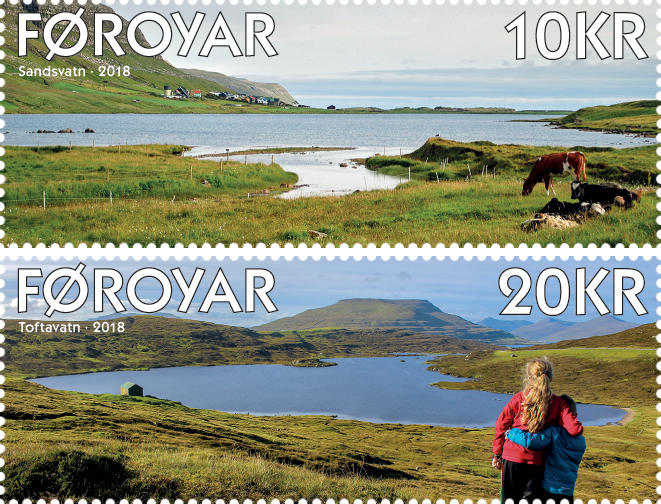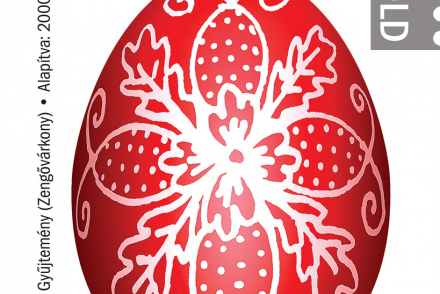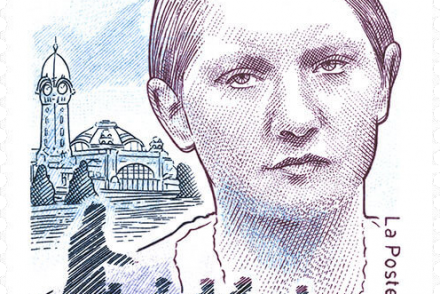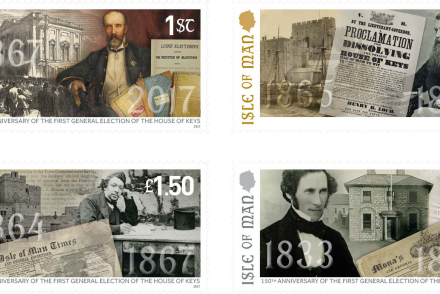Sandsvatn & Toftavatn
Faroes – The surroundings of major Faroese freshwater lakes are generally quite picturesque and Sandsvatn, the island‘s third largest lake on the island of Sandoy, is no exception. Sandur, the island’s largest town, is situated at the southern end of the lake. From there the lake stretches northwards through a long, sloping valley towards the town of Skopun.
Sandsvatn is approximately 2 kilometres long and 640 meters at its widest point. The lake’s surface area is 0.82 km2 and its deepest point about five meters. Originally, the elongated lake was a river basin created by eruption and erosion in the volcanic bedrock. Today a sandy shoreline, about 400m wide, separates the lake from the sea – hence the name of the town and the lake. On the shore, in close proximity to the lake, a grassy sand hill “Mølheyggjar” has emerged over time with thriving plants and insects not found elsewhere in the Faroes. Sandsvatn holds both trout and salmon and is a favourite place for anglers.
In addition to a number of small streams, two large rivers run into the lake, Dalsá from the north and Traðará from the east. The outlet is at the southern end, curving its way between Mølheyggjar out into the sea.
A small islet, Vatnsoyrarhólmur, is in the northern part of the lake. At the northern end we also find the island’s school buildings for older public school students, with facilities such as football pitch, a sports hall and swimming pool.
While the eastern side of the lake roughly stretches from south to north, there is a bay on the west side with a small promontory. This is Todnes, the site of the town‘s prefecture since ancient times. Todnes was the residence of two of the Faroe Islands most famous, not to mention notorious, clergymen.
Kálvur lítli (Calf the little) lived in the 14th century and became notorious for his wickedness. According to the folk tale, he was both a killer and a sadist, a greedy fellow in constant fight with his surroundings. The story has it that Kálvur lítli built a storehouse and pantry on the small islet of Presthólmur in the bay. The only way to reach the islet was by walking on stepping stones leading to the islet. One winter, six of his seven sons crossed the frozen lake intent on stealing food from their father. However, they strayed a little from the stepping-stones, the ice broke and all of them drowned.
The second clergyman was pastor Klæmint, Clement Laugesen Follerup (1602 – 1688). Pastor Klæmint was notorious for his greed. According to the story, the only possessions her had when he came to the Faroes were the ones he carried on his shoulders. At his death, however, he was the island’s largest landowners. The good pastor acquired his possessions with cunning and deceit; the only forms of payment he would receive were plots of land. Pastor Klæmint had many children, 23 according to legend – but “only” 15 of them inherited their father.
Located at the southwest of Sandsvatn is the district of Traðir where you still can still see the flat stone, Tingborð, the medieval place of the regional court.
Toftavatn – the Lake of Toftir
The Faroe Islands‘ fourth-largest lake is Toftavatn, situated in the hills between the towns of Toftir and Rituvik at the southern end of Eysturoy. Surrounded by heather hills and mounds, Toftavatn is one of the most beautiful spots in the Faroe Islands.
The lake itself has a surface area of 0.50 km2. It is located approx. 75 meters above sea level and its deepest point is approx. 22 meters. Small rocky crags stick out along the shores of the lake, contributing to the lake’s attractive features.
At the north end, the lake is divided by a man-made barrier of stones neatly stacked in the early 20th century. Since times of old, peat has been cut for fuel in the area and the barrier served as a shortcut when transporting the peat to the town of Toftir.
As stated above, the environment around Toftavatn is one of the most enchanting places in the Faroe Islands. It is located in the largest moorland areas on the islands. Three different species of heather grow on the hills and mounds. Common heather (Calluna vulgaris), blooming in late summer, is most prevalent in the area. More rarely seen is the cross-leaved heath (Erica tetralix) with its beautiful bell-shaped flowers. In addition, there is also the black crowberry (Empetrum nigrum), which blooms in May. Other plants include common cottonsedge (Eriophorum angustifolium), the tormentil (Potentila erecta) and woolgrass (Scirpus Caespitosus) – as well as many other plants, both rare and common.
In addition to the rich flora, Toftavatn is also known for its abundant bird life. Besides the ubiquitous black-backed seagull (Larus fuscus), the aggressive great skua (Stercorarius skua) and other species of seabirds, there is a large variety of moorland birds, such as the common snipe (Gallinago gallinago) and the oystercatcher (Haematopus ostralegus). The familiar red-throated loon (Gavia stellata) is also found here, being frequent close to most other lakes in the Faroes. In 1985, the first pair of graylag goose with chicks was observed on Toftavatn. Since then the stock of graylag goose (Anser anser) has grown and in July, when the geese start losing their flight feathers, they gather at Toftavatn. Seeing over a thousand geese on the lake is not unusual.
As is the case with most other great mountain lakes in the Faroes, legend has it that Toftavatn is also inhabited by a creepier creature. This is the so-called nixie that can metamorphose into other creatures, usually a horse, and sometime try to drag people down into the deep of the lake. If you touch the nixie you will stick to it and become its prey. Stories of the nixie have been told since days of old in order to keep children from going to the lakes which can pose danger to playful kids.
The neighbouring municipalities of Nes and Runavík created a system of pathways in 2007 to decrease the strain from tourists and other visitors. Toftavatn is a natural park which is definitely worth a visit – but it is also a delicate nature area to be treated with respect and caution.
Anker Eli Petersen
- 26.02.2018
- Fotographer: Jógvan Horn & Durita Jacobsen
- Cartor Security Printing, Frankrig
- Offset
- 56 x 21 mm
- 10,00 and 20,00 kr




